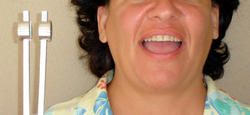Tuning Fork TherapyŽ
A Paradox of Pitch
The following information was retrieved from the LIFE Science Library book titled, "Sound and Hearing," by S.S. Stevens, Fred Warshofsky and the Editors of Time-Life Books. 1965.
Many thanks to my son, Paul, who took the photographs.
The Paradox-It is possible for one person to hear two different tones from the same tuning fork due to the brain's interpretation of pitch.
When the tuning fork is held far away from the ear
In 1937, psychophysicists at Harvard University began a series of experiments showing the relationship of pitch to frequency is not one-to-one.
It was discovered that when a singer would try to reproduce the note that she heard from a tuning fork held away from her ear, that she was able to reproduce it correctly.
When the tuning fork is held closer to the ear
But when the tuning fork was held close to the singer's ear, the sound from the tuning fork became louder and therefore the singer sang louder, singing a note that was different in both frequency and pitch.
In most cases, the note that the singer tried to reproduce was almost a half tone lower.
Most musicians feel that the higher musical octaves sound 'larger' than the lower ones.
Even though this experiment was to show a difference between pitch and frequency, it also shows the Tuning Fork Therapy(R) practitioner something new.
When the tuning fork is held at a distance from the ear, your brain will be more able to interpret the correct tones created by the tuning fork.
When the tuning fork is held too close to the ear, your brain may reproduce the tone it hears at almost a half tone lower than it should be.
This may help those of you who are finding disappointing results from their toning sessions. During your next session, try holding the tuning fork close to your ear and tone the note you hear, then hold the tuning fork away from your ear and tone the note you hear.
Do you notice a difference?
Note: Toning exercises are found in the Tuning Fork Therapy(R) Level One Manual for those of you who are new to Tuning Fork Therapy.
